Table of contents
Done well, chatbot marketing feels smooth, like a natural conversation. Done wrong, it is just another pop-up people ignore.
The real question isn’t if you should use chatbot marketing – it is how you do it right. And that is exactly what we are going to show you in this guide. We will discuss what works and what doesn’t, and give you a straightforward game plan to make chatbots turn conversations into conversions for your business the way they should.
What Is Chatbot Marketing?
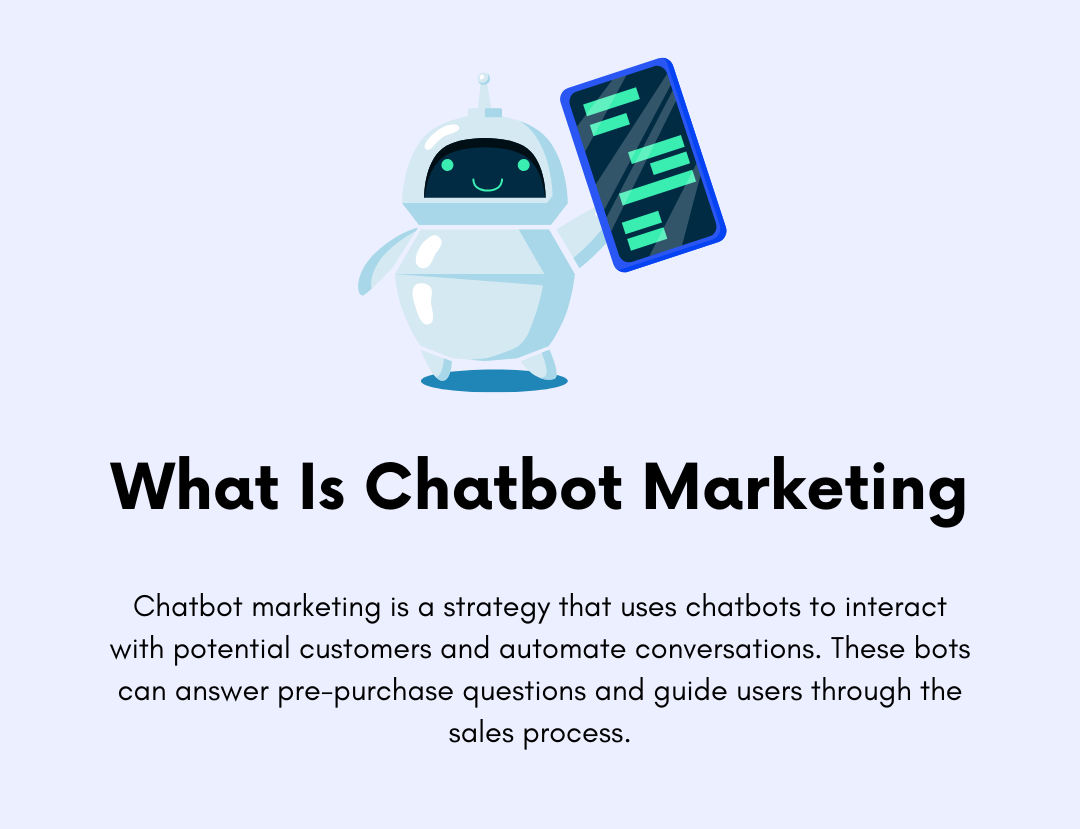
Chatbot marketing is a strategy that uses chatbots to interact with potential customers and automate conversations. These bots can answer pre-purchase questions and guide users through the sales process. You can use them to generate leads and personalize customer interactions.
Marketing chatbots can be used on websites, social media, and messaging apps to keep conversations going 24/7. Some chatbots are simple and follow scripts, while others use AI to personalize responses based on customer behavior.
How To Create A Chatbot Marketing Strategy That Works: 10 Easy Steps

Chatbots help generate 26% of all sales. This means they can be a marketing win or just another pop-up people ignore. The difference? Strategy. Set it up right, and it boosts conversions. Mess it up, and it is just annoying. Here’s how to get it right.
1. Decide What You Want Your Chatbot To Achieve
Before you do anything, you need to be clear on what your chatbot is actually supposed to do. Are you using it for lead generation or just making the buying process smoother? Without a clear goal, you will end up with a chatbot that is more of a digital distraction than a helpful tool for your marketing efforts.
How to Do It:
- List out the biggest problems your customers face when interacting with your business.
- Identify where your chatbot fits in your marketing funnel – top (awareness), middle (consideration), or bottom (conversion).
- Set a measurable goal, like “Increase lead conversions by 20%” or “Reduce customer support response time by 50%.”
- Identify key chatbot performance metrics (engagement rate, conversion rate, customer satisfaction score).
- Keep it simple – start with one core function and expand as needed.
2. Map Out The Customer Journey & Key Touchpoints
Your chatbot needs to fit naturally into how customers interact with your business. Think about the journey they take and identify the points where a chatbot can make things easier. If you place it randomly, it will feel intrusive instead of helpful.
How to Do It:
- Outline the major steps a customer takes before purchasing or reaching out for support.
- Identify the most common roadblocks customers face (e.g., product confusion, long response times, abandoned carts).
- Pinpoint the exact moments where a chatbot can provide value – like answering FAQs before checkout or capturing leads from website visitors.
- Decide on chatbot actions for each touchpoint (e.g., suggest products, collect email addresses, offer discounts).
- Test the journey yourself – go through your sales or support process and note where a chatbot could have made it smoother.
3. Optimize Chatbot Placement Across Key Marketing Channels
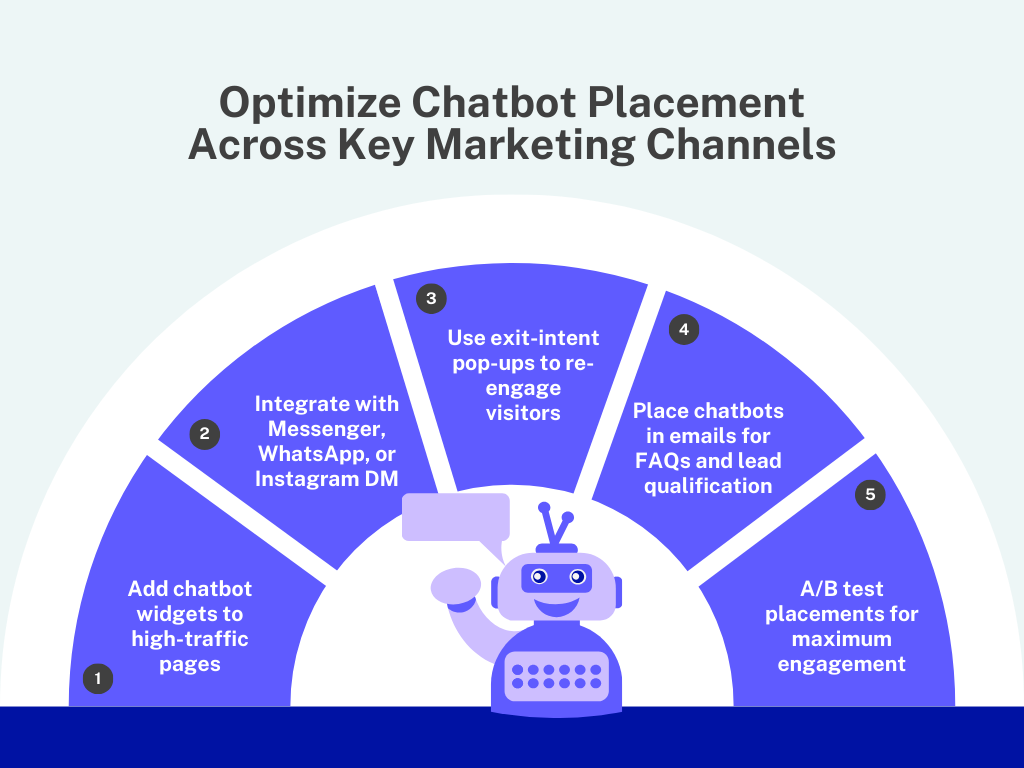
Your chatbot won’t be effective if nobody interacts with it. You need to strategically place it where your audience is most active – whether that is on your website, social media, or messaging apps. The point here is to make it easily accessible without being pushy.
How to Do It:
- Add a chatbot widget to high-traffic pages like your homepage, product pages, and checkout.
- Integrate your chatbot with Facebook Messenger, WhatsApp, or Instagram DM to engage customers where they already chat.
- Use exit-intent pop-ups to trigger chatbot conversations when a user is about to leave your site.
- Place chatbots in email campaigns to answer common questions and qualify leads.
- A/B test chatbot placement on different channels to see where it gets the most engagement.
4. Identify High-Intent Triggers For Chatbot Engagement
Not every visitor to your website is ready to chat, so you need to identify moments when they are most likely to engage. These high-intent triggers could be actions like spending a long time on a pricing page or adding an item to the cart but not checking out. Timing is everything.
How to Do It:
- Track user behavior – trigger chatbots when visitors spend X seconds on a pricing page or hover over the checkout button.
- Set up exit-intent chatbots that appear when someone is about to leave without converting.
- Use scroll-based triggers – if a visitor scrolls 50% down a blog, engage them with a chatbot offering related content or a lead magnet.
- Deploy intent-based chatbots for PPC landing pages to qualify leads instantly.
- Test different chatbot greetings – switch between direct CTAs (“Need help choosing?”) and engagement-focused questions (“What are you looking for today?”).
5. Use Data To Refine Chatbot Responses
Your chatbot shouldn’t just be set up once and left alone. The best chatbots constantly improve by learning from real interactions. Look at the data – are people dropping off mid-conversation? Are they asking questions your bot can’t answer? Use this feedback to fine-tune responses.
How to Do It:
- Review chatbot transcripts weekly to spot common questions that need better answers.
- Analyze drop-off points – if users abandon the conversation at a specific step, tweak that response.
- Use A/B testing to experiment with different chatbot messages and CTAs.
- Integrate chatbot analytics with Google Analytics or your CRM to track lead quality and conversion impact.
- Keep updating responses based on trends – if seasonal customer queries spike (e.g., holiday discounts), make sure your chatbot is ready.
6. Design Conversation Flows That Feel Natural
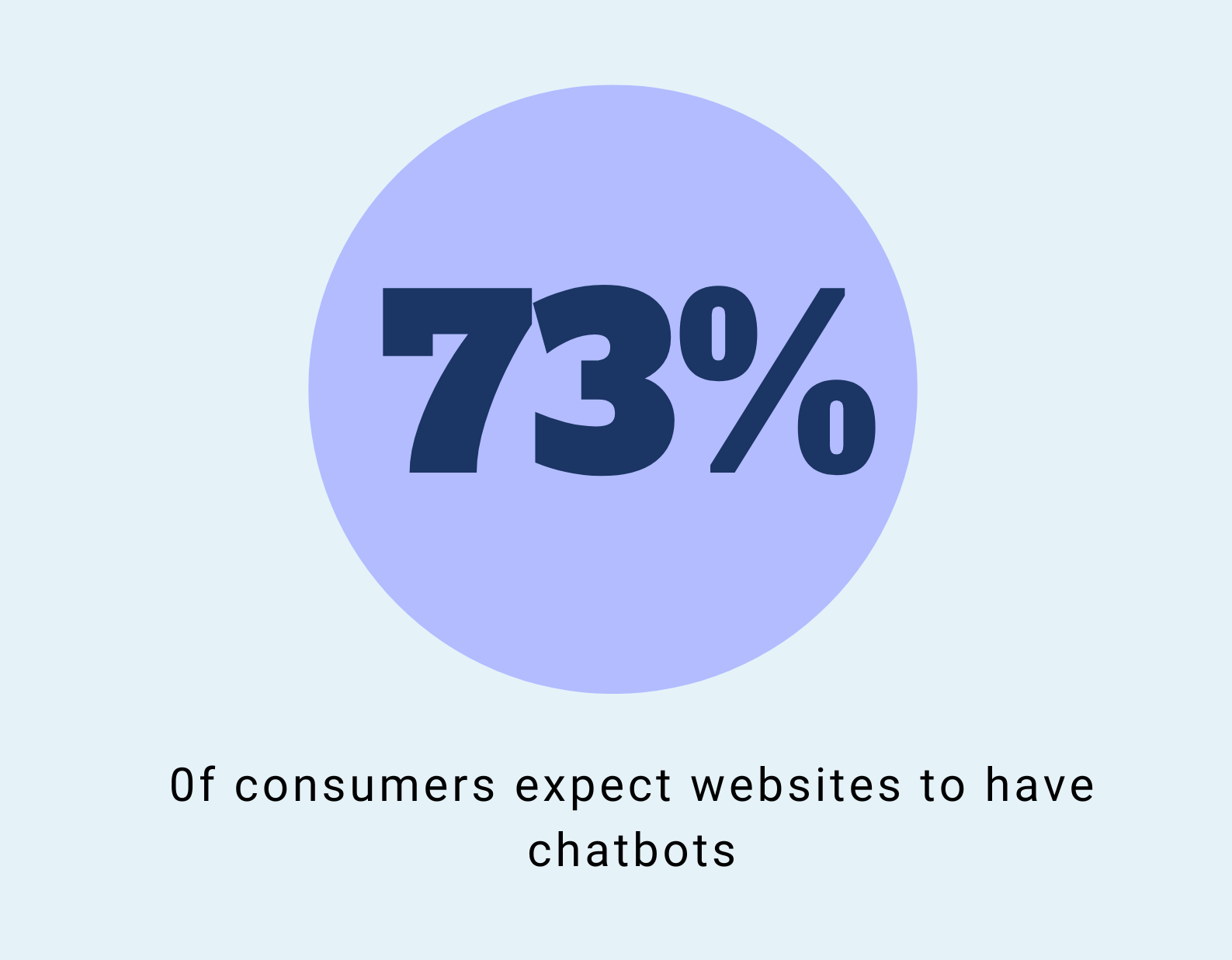
While 73% of consumers expect websites to have chatbots, nobody wants to talk to a robotic chatbot that sounds like a FAQ page. Your chatbot should feel like a helpful assistant that guides users through a conversation. The key is to make it sound human, keep messages short, and avoid overwhelming the user with too much info at once.
How to Do It:
- Write chatbot messages in a casual, friendly tone – avoid stiff, robotic language.
- Keep responses short and conversational. Ditch long paragraphs and stick to quick, engaging replies.
- Use buttons and quick replies to guide users (e.g., “I need help with pricing” vs. open-ended “How can I help?”).
- Personalize responses using user data. If they have visited before, acknowledge it (“Welcome back!”).
- Always provide an easy way to exit or speak to a human – forcing a chatbot loop is a fast way to lose leads.
Multilingual capabilities are also extremely important, as they can increase order turnover from chat by up to 20%, as you can read in our article on Ecommerce Bridge.
7. Integrate Chatbot Analytics To Track Drop-Off Points
A chatbot is only as good as the data behind it. If users are dropping off mid-conversation, something isn’t working. Maybe the chatbot is too pushy, not relevant enough, or failing to provide helpful answers. Track where users disengage to tweak your responses and improve conversions.
How to Do It:
- Use built-in chatbot analytics to see where users stop responding or exit conversations.
- Set up heatmaps and session recordings to watch how users interact with the chatbot on your site.
- Monitor conversation logs for frequently abandoned chat flows and refine those responses.
- Compare chatbot engagement vs. conversion rates – if people chat but don’t take action, adjust the CTA.
- Test small tweaks, like changing the wording of the questions or response time, and track if drop-off rates improve.
8. Align Chatbot Goals With Specific Marketing KPIs
Your chatbot should support your overall marketing strategy, not just exist for the sake of having one. Whether your goal is to increase conversions or improve customer support, you need to tie chatbot performance to measurable KPIs.
How to Do It:
- Define one primary KPI. It could be chatbot-assisted lead generation, email signups, or sales.
- Break it down – track micro-conversions like the number of users who reach the final chatbot step.
- Use chatbot performance data to refine overall marketing strategy. For example, if users ask about pricing a lot, highlight it more in ads.
- Integrate chatbot data with your CRM or Google Analytics to track its impact on lead quality and sales.
- Set up automated reports to review chatbot performance weekly and make data-driven adjustments.
9. Create Fallback Responses To Prevent Dead-End Conversations
Nothing kills a chatbot experience faster than a dead-end response like “Sorry, I don’t understand.” If a chatbot can’t answer a question, it should guide the conversation back on track instead of leaving users stranded.
How to Do It:
- Set up smart fallback responses like “I’m not sure, but here’s a link that might help!” instead of dead-end errors.
- Use buttons and quick replies to take users toward relevant options instead of leaving them stuck.
- If the chatbot struggles with a question, train it to ask clarifying questions rather than giving up.
- Program the chatbot to escalate to a human when it detects frustration or repeated failed responses (more on this in the next step).
- Regularly review logs and collect customer feedback to find common fallback triggers and improve chatbot training.
10. Train The Chatbot To Hand Off To Human Agents When Needed
No chatbot can handle everything, and it shouldn’t try to. Sometimes, users need a real human to step in, especially for complex questions, VIP customers, or high-ticket sales. A smooth handoff ensures that customers don’t get frustrated and leave.
How to Do It:
- Set clear escalation triggers, like repeated fallback responses or high-value inquiries (e.g., pricing for enterprise plans).
- Let users request a human agent at any time with a simple button like “Talk to an agent” instead of forcing them through chatbot loops.
- Use live chat integrations so agents can easily take over the conversation without the user repeating themselves.
- Implement business hours – if no agents are available, set up an option for users to leave a message or schedule a callback.
- Train the chatbot to pre-qualify leads before handing them off, collecting key details (name, issue, urgency) to help agents respond faster.
How Can Businesses Use Chatbot Marketing: Understanding Different Use Cases
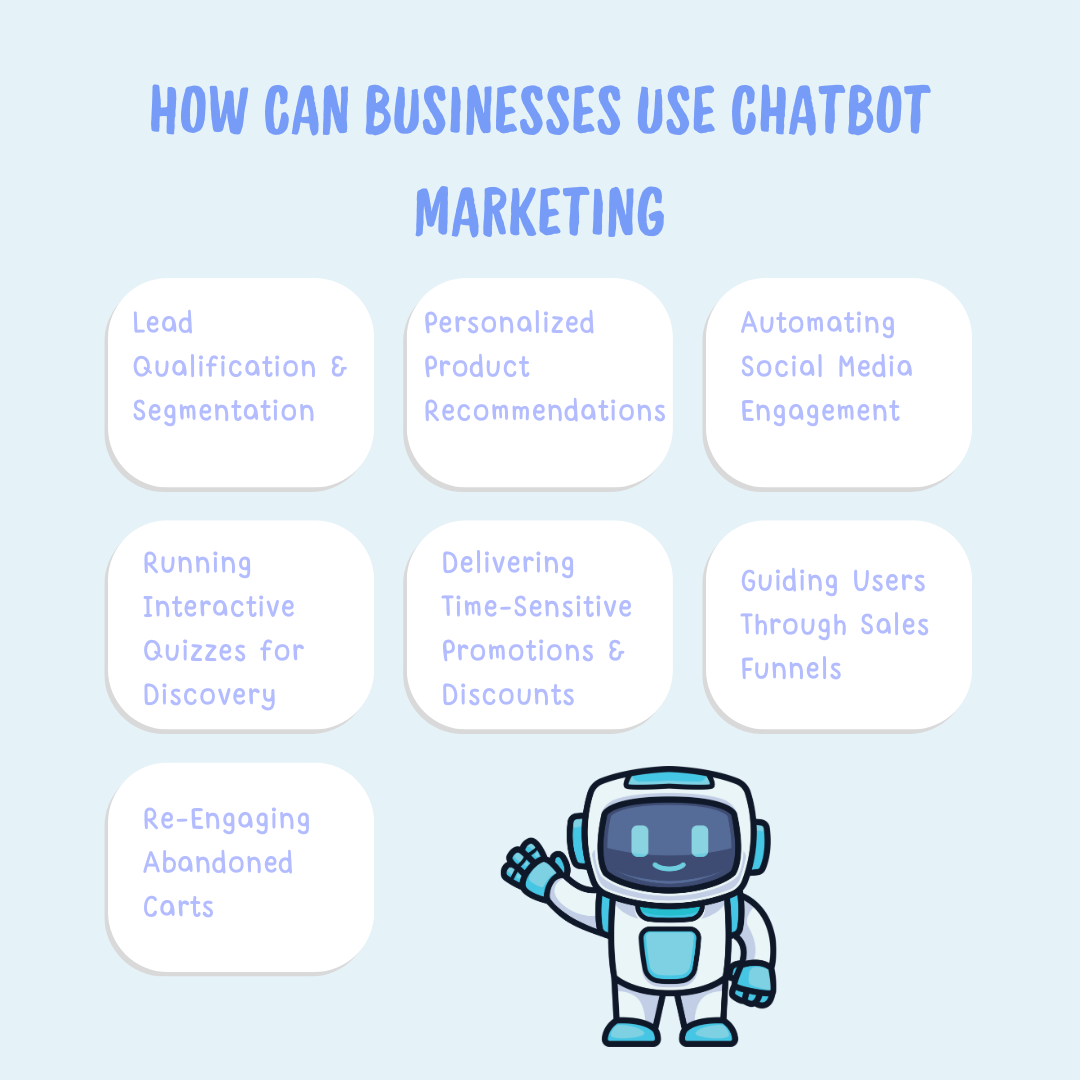
When done right, chatbots can act like your best salesperson. Let’s look into some smart chatbot marketing examples to see how businesses are using them to get real results.
I. Lead Qualification & Segmentation
55% of businesses say chatbots bring in better leads. But not all leads are ready to buy. A marketing chatbot can instantly qualify leads by asking the right questions and sorting them into categories based on interest level. This helps businesses focus on hot leads while keeping casual browsers engaged.
How It Will Work in Practice:
Let’s consider the example of this online store selling kids’ playhouses. Unlike smaller, everyday purchases, a playhouse is a big decision – both in size and cost. Parents want to know about dimensions, materials, safety, and, of course, what their kids will love most.
This store can use a marketing chatbot to make this process easier by guiding customers through the options and helping them find the perfect fit.
Here’s how they do it:
- Ask parents about their backyard size, budget, and child’s age to recommend the best playhouse options.
- Use fun, engaging multiple-choice questions to match playhouses with different play styles (e.g., “Does your kid love climbing or pretend play?”).
- Instantly connect high-intent buyers with a live chat agent if they have specific customization requests.
- Provide different chatbot flows for first-time visitors (educating them on benefits) versus returning shoppers (helping them compare models).
- Sync chatbot data with the store’s CRM to send follow-up emails with personalized offers, like a discount on matching play accessories.
II. Personalized Product Recommendations
People love recommendations that actually make sense for them. That is exactly what chatbots can do. Instead of making customers dig through pages of products, chatbots can ask a few quick questions and instantly recommend the perfect option.
How It Will Work in Practice:
While using chatbot marketing for personalized product recommendations is important for any business, it becomes all the more important for a niche business like this online store for golf cart accessories. These are not everyday purchases, and customers often don’t know exactly what they need.

Unlike clothing or tech gadgets, these products require compatibility with specific cart models, making it harder for shoppers to find the right fit. A chatbot makes this process painless by offering personalized guidance.
Here’s how they should do it:
- Ask targeted questions about the customer’s golf cart model, usage (casual rounds, tournaments, or utility use), and specific needs (comfort, storage, or weatherproofing).
- Display product recommendations in an easy-to-scroll chat format.
- Use AI to pull product recommendations based on past purchases or browsing history.
- Offer limited-time discounts on recommended accessories to create urgency.
- Integrate with Shopify so customers can add products to their cart and check out without leaving the chat window.
III. Automating Social Media Engagement
Social media is great for marketing, but responding to every DM or comment manually? Not so much. Chatbots can handle these interactions at scale, all while keeping your brand responsive and interactive.
And truth be told, this matters even more if you are selling on third-party marketplaces like Amazon. When you don’t own the platform, you don’t control the customer journey. But social media gives you that control.
You can use marketing chatbots to guide potential buyers through their sales journey and even direct them to your store. Instead of relying solely on marketplace algorithms, you are creating a direct path for engagement and conversions.
How It Will Work in Practice:
Now, let’s take an Amazon mattress seller as an example. Buying a mattress isn’t a quick decision – customers want comparisons and reviews for reassurance that they are making the right choice.
A great way to stand out is by creating a comparison of the best mattresses and posting it on review sites. Then, share it on social media and use marketing chatbots to keep the conversation going. This turns casual browsers into confident buyers, even before they hit your Amazon listing.
Here’s how to do it the right way:
- Set up Instagram and Facebook chatbots to instantly reply to DMs and direct users to your comparison post or Amazon store.
- Automate replies for common questions like firmness levels, warranty details, and delivery options.
- Capture leads from social ads by having a chatbot engage visitors with interactive recommendations based on their sleep preferences.
- Run chatbot-powered contests to help users find their perfect mattress and offer exclusive discounts to encourage purchase.
- Follow up with social media visitors by providing additional sleep tips and customer reviews for conversions.
IV. Running Interactive Quizzes For Product/Service Discovery
People love interactive experiences, and quizzes are an easy way to guide potential customers toward the right products without feeling like a sales pitch. A chatbot-led quiz can be engaging and incredibly effective at turning hesitant shoppers into confident buyers.
How It Will Work in Practice:
Now, imagine you offer an online guitar course for beginners, along with more advanced lessons and specific services. Unlike physical products, online courses require extra trust before someone commits. People worry about whether a course is right for them, whether they will actually learn something useful, or if they’ll even stick with it.
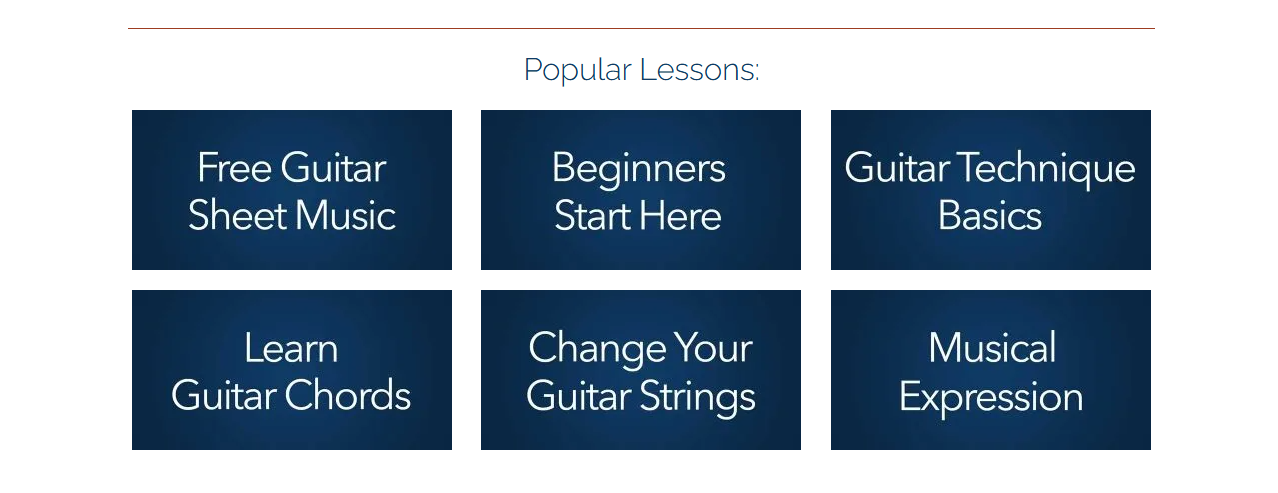
That is why interactive quizzes are a perfect fit here. They help potential students figure out where they should start and make the decision easy and exciting rather than overwhelming.
Let’s see how you can do it right:
- Use a chatbot to ask fun, engaging questions like “What is your favorite music genre?” or “How long have you been playing?” to personalize recommendations.
- Design quiz results that feel customized, such as “You are a rockstar in the making! Start with our Beginner Guitar Course.”
- Collect emails at the end of the quiz by offering a free intro lesson or practice guide.
- Integrate quizzes with course pages so users can instantly enroll in the recommended course.
- Offer an incentive or a discount on their first lesson or a free trial to encourage sign-ups.
V. Delivering Time-Sensitive Promotions & Discounts
Ever seen a flash sale or limited-time offer that almost made you buy, but you got distracted? Using chatbots for marketing helps online businesses catch potential buyers at the right moment by delivering time-sensitive discounts and nudging them to take action before it is too late.
How It Will Work in Practice:
Now, imagine an online store that sells handcrafted, limited-edition ceramic mugs. Unlike mass-produced mugs, each design is unique and only available in small batches. Once they are gone, they are gone. You can use a chatbot can highlight this exclusivity and make sure potential buyers don’t miss out on their favorite piece.
Here’s how you can make it work for your business:
- Trigger chatbots to pop up with exclusive eCommerce discounts for first-time visitors who show interest in a limited-stock design.
- Use countdown timers in chatbot messages to emphasize when a collection is about to sell out.
- Send chatbot reminders about new product drops and pre-order opportunities before inventory runs out.
- Offer personalized discounts based on user behavior (e.g., “You loved our last collection! Here’s early access to our next release.”).
- Integrate with SMS or email so chatbots can follow up if users don’t act immediately.
VI. Guiding Users Through Sales Funnels
Not every visitor is ready to buy right now, and that is okay. A chatbot can help users move through the sales funnel step by step – whether that means answering questions, offering product comparisons, or pushing them toward a demo or consultation.
How It Will Work in Practice:
Consider this business selling outdoor kitchen sinks. This isn’t an everyday impulse buy – it is a planned purchase that homeowners and designers research thoroughly. They want to know about durability, installation, and how it fits into their outdoor kitchen setup.

A marketing chatbot can help them decide by answering technical questions and nudging them toward making a confident purchase.
Here’s how you can do it:
- Use chatbots to ask questions like, “Are you looking for a freestanding or built-in sink?” and recommend the best options.
- Provide instant side-by-side comparisons of materials like stainless steel vs. granite composite to help buyers decide.
- Offer real customer stories and before-and-after photos to show how an outdoor sink can elevate their space.
- Allow users to schedule a quick consultation with a design expert directly through the chatbot.
- Nurture leads by collecting emails and sending helpful tips on outdoor kitchen planning, along with exclusive promotions.
VII. Re-Engaging Abandoned Carts With Tailored Marketing Messages
Cart abandonment is a massive problem for online stores. But using chatbots for abandoned carts can increase eCommerce revenue by 7%-25%. They help bring users back by sending friendly reminders and answering last-minute doubts.
How It Will Work in Practice:
Now, let’s consider this business selling medical alert systems for the elderly. This isn’t just another online purchase – it is a decision that directly impacts safety and peace of mind. Families research for days and weigh options carefully before buying.
Because of this, abandoned carts in this industry usually mean uncertainty, not just hesitation. A chatbot can step in at the right moment to reassure them and provide the clarity they need to complete the purchase.
Here’s what they can do:
- Trigger chatbot reminders when a user leaves without completing checkout, offering reassurance about reliability and ease of use.
- Offer real-time support for common concerns, like “Worried about setup? It is plug-and-play, and we offer free assistance!”
- Send personalized discounts or added value offers (e.g., “Complete your order now and get free fall detection for 3 months!”).
- Use conversational nudges like “Still deciding? Hear how this system saved John’s mom in a real emergency.”
- If users don’t return, follow up via email, SMS, or social DMs with chatbot-driven reminders and success stories to rebuild confidence.
Why Having an Effective Chatbot Marketing Strategy Matters: 7 Key Benefits
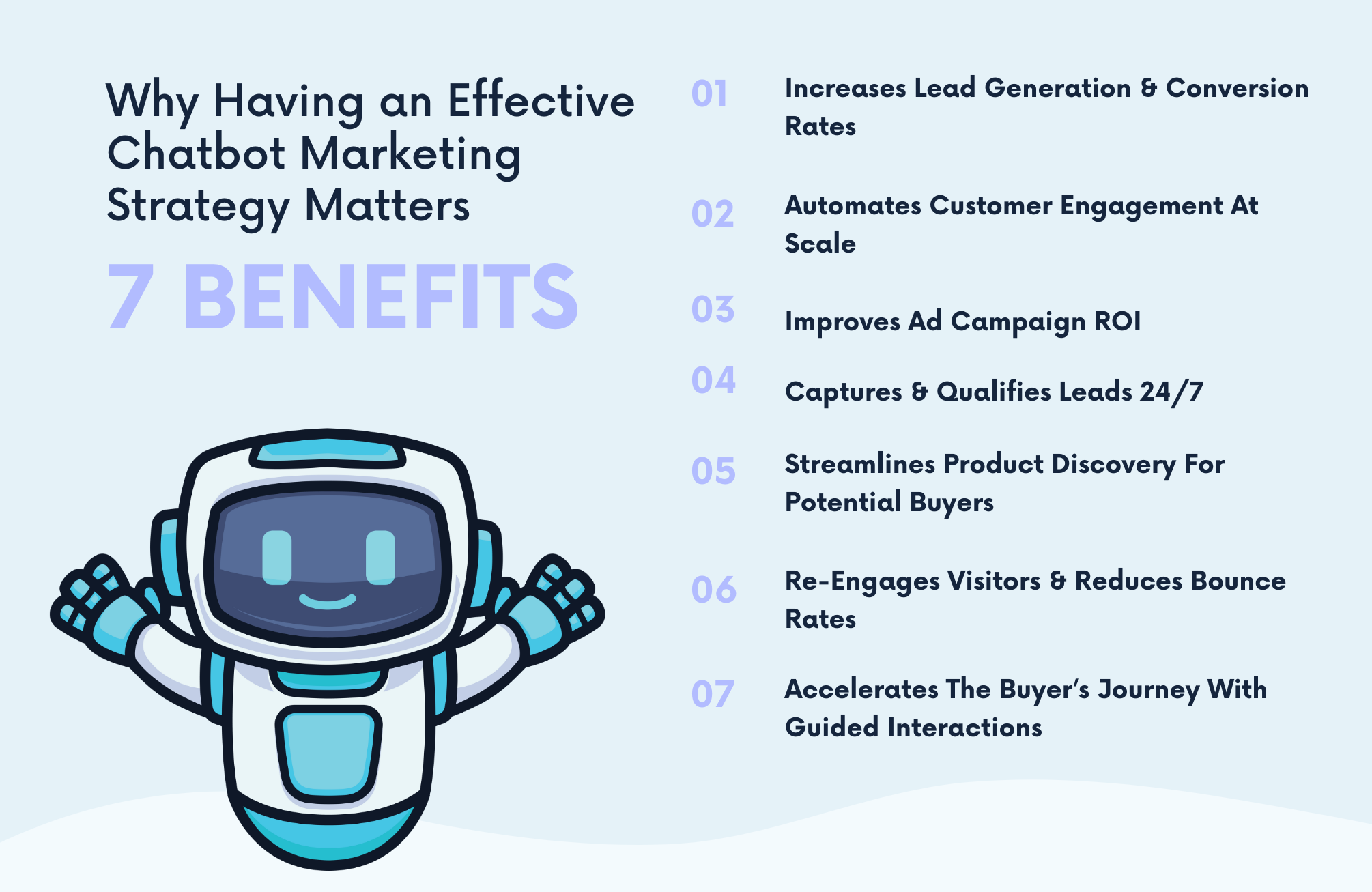
A chatbot is only as good as the strategy behind it. If it is just sitting there waiting for users to type first, you are missing out on huge opportunities. Let’s talk about why an effective chatbot marketing strategy actually matters.
A. Increases Lead Generation & Conversion Rates
Most visitors don’t stick around long enough to fill out a form or browse every page of your site to find what they need. A chatbot fixes that by jumping in at the right moment and guiding them before they lose interest. It can ask simple, engaging questions that keep them involved – like “Looking for something specific?” or “Need help picking the right product?”
B. Automates Customer Engagement At Scale
There is no way a human team can respond instantly to every inquiry, especially when messages start piling up across different platforms. That is where chatbots make a huge difference.
They engage multiple visitors at once without making anyone wait. Someone lands on your website at midnight? No problem. The chatbot is there to answer questions and move them closer to a sale.
C. Improves Ad Campaign ROI
We all know ads are expensive, and if someone clicks on yours but leaves without taking action, that is money wasted. A marketing chatbot can capture those clicks and turn them into actual leads.
Instead of just dumping people onto a landing page and hoping they convert, a chatbot can immediately start a conversation, ask a few questions, and nudge them in the right direction. Plus, with chatbot analytics, you get real-time data on how your ads are performing, so you can tweak and optimize based on actual engagement.
D. Captures & Qualifies Leads 24/7
Unlike human sales reps, a chatbot doesn’t call in sick and doesn’t log off at 5 PM. It is always on, making sure that every visitor who lands on your site has a way to engage. And it qualifies leads on the spot by asking key questions about their needs, budget, or timeline.
That means when your sales team does step in, they are talking to people who are actually ready to buy, not just casual browsers. Plus, all that lead data gets stored in your CRM, so nothing is missed.
E. Streamlines Product Discovery For Potential Buyers
Nobody wants to scroll through dozens of product pages trying to figure out what is best for them. A chatbot makes shopping way easier by acting like a personal shopper. It can ask what someone is looking for, suggest options based on their preferences, and even compare products side by side. This works especially well for brands with a huge inventory.
F. Re-Engages Visitors & Reduces Bounce Rates
Most visitors leave a website without taking any action, and once they are gone, getting them back is tough. A chatbot can help stop that from happening by re-engaging visitors before they exit.
If someone has been inactive for a while, the chatbot can show up with a quick question like, “Still deciding? Let me help!” or “Need a little extra incentive? Here’s 10% off your first order.”
Even if they do leave, a chatbot can follow up via email, SMS, or social DMs, reminding them of what they left behind and bringing them back when they are ready to buy.
G. Accelerates The Buyer’s Journey With Guided Interactions
A slow or complicated buying process is a conversion killer. If customers have to dig for information, wait for a response, or figure things out on their own, chances are they will just leave instead.
A chatbot eliminates those hurdles by guiding visitors step by step through the buying process. It answers common questions in seconds, directs users to the right pages, and even provides social proof – like customer reviews or case studies – to build trust. If a visitor seems ready but is still hesitant, the chatbot can offer a live chat option with a human rep to seal the deal.
How Smartsupp Fast-Tracks Your Chatbot Marketing Strategy
Implementing a chatbot strategy can be complex, but at Smartsupp, we simplify the process. Our comprehensive chatbot platform is designed to enhance online interactions and boost sales for businesses. Let’s discuss this in detail:
- The platform’s AI Shopping Assistant, Mira, learns from your product feed to provide personalized product recommendations and instant assistance.
- Smartsupp offers an easy-to-use chatbot builder for quick deployment of chatbots that can engage visitors and guide potential customers through their buying journey.
- With Smartsupp, you can automate customer interactions, even outside of working hours. Chatbots can handle advanced inquiries and determine when to escalate the conversation to a live agent.
- The platform provides in-depth analytics, including conversation ratings and chatbot performance metrics.
- Smartsupp integrates with various platforms, including WordPress and Shopify, and offers mobile applications for iOS and Android devices.
- Data privacy is a priority for Smartsupp, with data securely stored within the European Union in compliance with strict EU data protection laws.
Conclusion
Chatbot marketing strategy is all about how you use it. Sloppy automation? Customers bounce. Generic responses? Engagement drops. But when you integrate chatbots into a bigger marketing plan, that is when things change. So the best way to go about it is to test different approaches, refine your messaging, and track what works. And most importantly, don’t overcomplicate it.
If you are wondering how to pull this off without turning your chatbot into just another robotic assistant, Smartsupp can help you with that. It not only lets you chat live with your website visitors but also employs AI to handle up to 80% of common customer questions. Plus, with seamless integration across platforms like Shopify and WordPress, getting started is a breeze.
Go ahead and sign up for free or book a demo to see how easy chatbot marketing can be.


